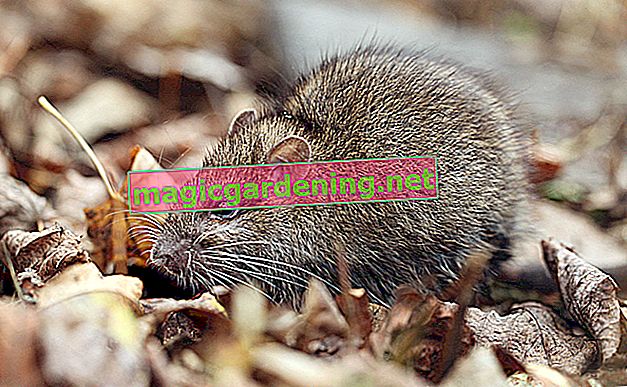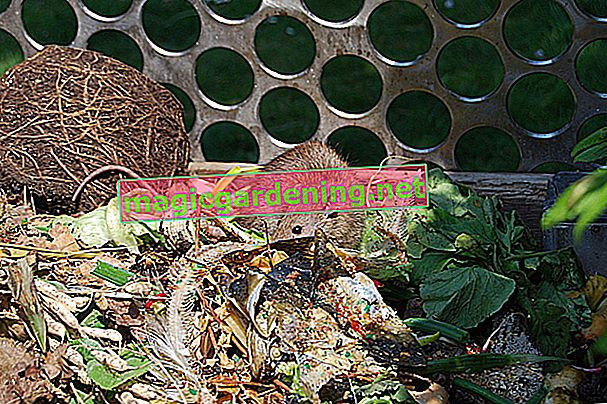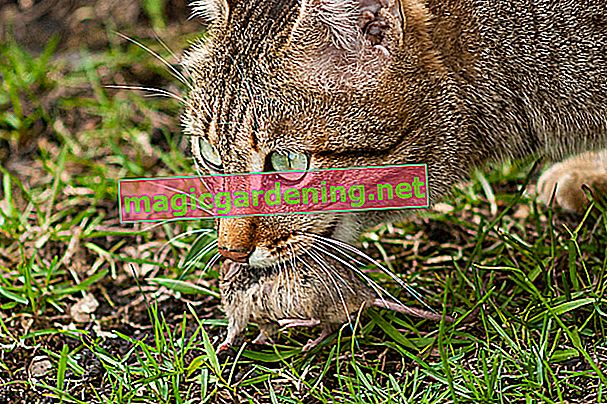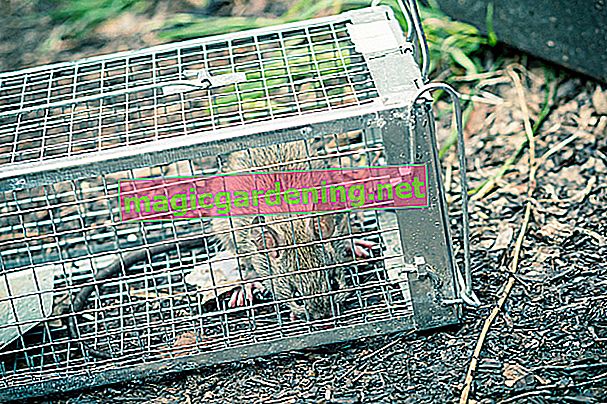
the essentials in brief
- Rats in the garden are notifiable. This reporting obligation also applies if there is just a justified suspicion.
- Notes for rats in the garden are holes, nests, rat droppings, walking streets and gnawing marks.
- You can drive away or fight isolated rats without poison. If rats are running around in the garden in broad daylight, a professional pest controller will solve the problem.
Do you have to report rats in the garden?
According to Section 2 of the Infection Protection Act, rats are dangerous health pests that can transmit more than 100 diseases to humans. For this reason, rats in the garden are required to register in Germany. Furthermore, rat infestation in real estate of all kinds as well as on ships and other means of transport must be reported. The following overview summarizes who is obliged to report in an emergency:
- Property owner
- House and apartment owners
- Landlords and tenants of residential real estate or commercial space
- Condominium Company Administrators
- Beneficiaries (tenants) of land
- Owners or authorized users of ships
also read
- Getting rid of rats in compost - tips and tricks
- Do martens eat rats?
- Fighting hawkweed in the garden - tips for combating
There is no deadline for reporting rat infestations. However, citizens are called upon to report suspected rats in the garden or house. Rats within the meaning of this regulation are house rats (Rattus rattus) and brown rats (Rattus norvegicus) alike. Anyone who does not comply with his reporting obligation commits an administrative offense which is punishable by a fine.
How to properly report rat infestations

The local public order office is responsible for rats in the garden. Rat infestation can be reported to the authorities either orally or in writing. The notification should contain at least the following information:
- Name of the reporting person
- which property is affected
- Name and address of the property owner, landlord and, if applicable, administrator
- whether and when the property owner was informed
Further information is helpful. Let the officers know exactly what leads your urgent suspicion is based, such as rat droppings and suspicious holes. If rats are already walking through the garden in broad daylight, use this information to underpin the urgency of taking adequate countermeasures.
Tenants of a property are also obliged to send the information about the pest infestation to the landlord. If you have fulfilled your reporting obligation, the public order office will promptly initiate risk investigation measures. The competent authority can either determine the extent of the rat infestation by its own officials or commission a specialist company.
Digression
Rats - dangerous and willing to reproduce
Numerous animal species have made the leap from pests to beneficials in the garden. That doesn't apply to rats. Since the Middle Ages, rodents have made life difficult for us as threatening carriers of diseases such as plague, cholera, dysentery, toxoplasmosis and the life-threatening hantavirus infection. The rabble contaminates our food supplies with stinking feces and urine. Rats are nocturnal and shy. If the beasts feel cornered, they become aggressive and bite. Their willingness to reproduce is record-breaking. Reproduction takes place almost all year round, with an average of 8 young per litter and 6-8 litters per year and female. Brown rats are sexually mature after 2 to 3 months, house rats after 3 to 4 months.Recognizing rats in the garden - tips

Where do rats live in the garden? If you know the answer to this question, you can track down the pests at an early stage. Rats dig holes as entrances to their burrows, always use the same walkways and gnaw almost all materials. The following table indicates typical signs of the presence of rats in the garden:
| Holes and nests | Rat droppings | Walkways | Gnaw marks |
|---|---|---|---|
| Dandruff | 0.5-1 cm (domestic rat) | Garden paths | on flower buds |
| garage | 1-2 cm (brown rat) | along the wall | on leaves |
| Decking | evenly distributed (house rat) | trodden dirt | of wood |
| Compost heap | piled up (brown rat) | Step seal in the dust | on cables, pipes |
| Tree grate | bad stench | of plastic | |
| Drain pipe cover |
Did the above information reinforce your suspicion that a rat problem is looming in your garden? Then please read the following in-depth information.
Discover holes and nests
Rats in the garden prefer to build earthworks with at least two entrances. These entrances are always open and lead to a living room boiler and one or more pantries. Each entrance can be recognized as a round hole with a diameter of 3 to 5 centimeters. The main corridors behind are 8 to 9 centimeters high, 11 to 12 cm wide and cross-oval. A brown rat nest, or free-roaming house rat, is made up of leaves, grass, scraps of paper, and other soft material. The following overview sums up where the telltale holes can be in the garden:
- Shed and garage: on the edge of a wall or wooden wall at a distance of a few centimeters
- Decking: along the edges of the deck
- Compost container: round to oval holes gnawed in the bottom or lid
- Tree grate: openings between tree and bush roots
- Drain cover: right next to the drain cover, often with gnaw marks on the lid itself
If dirt has accumulated in front of the holes or if cobwebs hang in front of an entrance, the rats have left the nest. If there are no further openings to be found in the garden floor, the chalice has passed you and the rabble of rats has moved on.
Identify rat droppings

Most rat faeces can be identified from a distance by a strong ammonia smell. In the garden in the fresh air, the stench is less intense than in buildings. When in doubt, the following properties reveal that it is rat excrement:
- brown to black-brown
- cylindrically shaped
- blunt ends (brown rat)
- rejuvenating spiral shape (house rat)
Fresh, shiny rat droppings are a symptom of current infestation. If you only find dry, crumbly faeces in the garden, the monsters have left the property. Please exercise caution during the assessment. Even when dried, rat droppings are infectious for some time if you inhale suspended particles.
Recognize runways
Rats don't see well. For this reason the rodents prefer to move on well-known routes. In the garden, this has the advantage that there are regular trails that are easy to see. Narrow, well-trodden tracks are typical. Furthermore, rats often leave unambiguous footsteps in the garden consisting of front paws with four toes and rear paws with five toes with an extra long middle toe. In addition, rats do not lift their long tails when they run. This behavior creates a dragging track between the footprints.
Correctly assign gnaw marks
As omnivores, rats are equipped with powerful teeth. Few materials can withstand the incisor teeth. As a result, there is a lot of damage to plants in the garden. In springtime, hungry rats climb tree trunks as fast as they can to grab flower buds and leaves. This leads to fatal crop losses on fruit trees. The little fruit that ripens in autumn is mercilessly nibbled on.
In rats, the incisor teeth grow incessantly. This forces the fur wearers to gnaw even when they are actually not hungry. The result is considerable material damage, especially to wood, cables, pipes, garden tools, birdhouses or garden furniture. Two parallel grooves are typical rat gnawing marks.
Rats in the garden - what to do?

Private garden owners are legally obliged to report a rat infestation to the public order office. This reporting requirement exists so that the municipality can use more poison bait in public areas in the vicinity. Measures to control rats in your own garden, however, are the responsibility of the hobby gardener. Depending on the infestation pressure, there are various options for getting rid of rats in the garden. The following table gives a summarized overview:
| To evict | Fight without poison | Fight |
|---|---|---|
| turpentine | Live trap | Rodenticides |
| used cat litter | Snap trap | Pest Control |
| Chili powder | Predators | |
| Iron vitriol |
Smart solutions for effective rat control indoors and outdoors are on the advance. Rentokil is a pioneer in the German market with the patented AutoGate rat bait station. The Austrian provider Smarthygiene goes one step further with its innovative SmartWiseBox for rat control without poison. The effort for monitoring, installation and surveillance has so far been too expensive for private users. The offer is aimed at companies in the food industry and other risk trades that can handle the high costs. It is to be hoped that modified solutions for private users will not be long in coming.
Chase away rats in the garden
For natural hobby gardeners, the first signs of rats in the garden are a good reason for the poison-free deterrent. Rats can see very poorly, but smell all the better. Effective means are aimed at their fine sense of smell in order to successfully drive rats out of the garden. This is how it works:
- Turpentine : soak old rags with turpentine and lay out in the garden
- Cat litter : fill used cat litter into air-permeable bags and place them strategically
- Chili powder : sprinkle chili or pepper powder on the streets (refresh after every downpour)
- Iron vitriol : Distribute iron vitriol (green salt) on suspicious areas
We recommend using the four remedies alternately. This way, rats in the garden cannot get used to a certain smell and then ignore it.
Tips
When rats come into the garden, the animals simply follow their natural instincts in search of shelter and food. Natural hobby gardeners do not condemn the intruders to an agonizing death. The frequently touted pesticide made from porridge with plaster of paris causes severe digestive pain with a long agony and is frowned upon in animal-friendly gardens.
Fight rats in the garden without poison
YoutubeThe effectiveness of odors as a repellent against rats is shaky. So far, the success has not been proven in any serious study. If you are fighting rats in the garden with no poison but with visible results, the following three options come into focus:
Live trap
You can buy a live trap for rats in specialist shops or build it yourself. The construction catches the animals without harming them. The rat is released at a safe distance of at least one kilometer from inhabited places. How to properly control rats in the garden with a live trap:
- Location : on walkways or next to sites with rat droppings
- Bait : peanut butter, Nutella, pieces of cheese or bacon
- Check : every 8-12 hours
It is important to note that for an animal-friendly process it is important to provide enough water and feed for transport to the release site.

Snap trap
If the use of live traps is out of the question, classic snap traps put an end to rats in the garden. The experts at the Federal Environment Agency advocate this control method instead of taking the risks of rat poison. For maximum success, the experts advise not to tension the trap and bait for a few days. So the suspicious rats can get used to it. Snap traps should be placed in shelter stations to protect children and pets.
Hire predators
Can't you get used to the close contact with rats in live traps or the brute force of snap traps? Then get powerful support from the animal kingdom. These animals like to eat rats in the garden:
- cat
- dog
- Owl, especially eagle owl
- Beech marten
- Hawk, buzzard
When dog and cat smell a rat, the natural hunting instinct is immediately awakened. So that pets can actually get rid of the pests, they should be able to stay in the garden for several hours every day and at night if possible. If the natural garden has a nesting box (€ 8.76 at Amazon *) for owls, the rat enemies will find their way around by themselves. Martens warmly welcome you with piles of stones and mixed hedges as retreats instead of scaring the creatures off with smells. If hawk or buzzard find a perch in the garden as a vantage point, the predators make short work of careless rats that venture out of the nest during the day.
Fight rats in the garden with pest experts
If rats frolic in the garden in broad daylight, it is too late for gentle remedies. It is often acute overpopulation that forces rats to forage for food even in daylight. A large population of rats represents a high health risk for the entire environment and leaves little room for maneuver even for animal-friendly hobby gardeners.
The Federal Environment Agency urgently advises against daring experiments with rat poison, so-called rodenticides. Food baits contain active substances that inhibit blood clotting in the rat body. As a result, the animal will bleed to death within 3 to 7 days of ingestion. If other animals eat the bait or a dead rat, such as dogs, cats, rabbits, hedgehogs or deer, they will also die from the consequences. The deadly danger that rodenticides pose to children cannot be imagined.
A professional pest fighter is qualified to safely and reliably control rats in the garden. After making contact, the specialist first inspects the garden and adjacent buildings. He then creates a well thought-out pest control plan, precisely tailored to the local framework conditions. If the plan provides for the use of poisonous food bait, these are placed in tamper-proof bait boxes. Thanks to expert rat control, you will be rid of the plague within a short time with guaranteed safety for you, your family, pets and animals in the garden that are worth protecting.
frequently asked Questions
Our neighbor has rats in the garden and doesn't care. Should we report the rat infestation to the public order office?
As soon as a stronger rat infestation is noticed on a site, the legal reporting obligation takes effect. This obligation is also valid if it is a public space or a neighboring property. If it is more than a single copy, please do not hesitate to contact the regulatory office with this observation.
What do rats eat in the garden?
Rats are omnivores with strong incisor teeth. Once the animals have nested in the garden, no plants are safe from the beasts. Rats prefer to plunder the food supplies of chickens, ducks and fish. Kitchen waste disposed of on the compost heap is a land of milk and honey for the rodents. Even when rats are not hungry, they will continue to eat in order to grind away the constantly growing incisor teeth. In this case, wooden planks, plastic buckets, cables, pipes and garden furniture have to believe in it.
Rats have settled in my leased garden. Does the pest allow me to reduce my rent to the landlord?
Because rats are a health hazard, you as a tenant are generally entitled to a rent reduction until the landlord has rectified the defect. The extent to which you can reduce the rent depends largely on the general conditions. Rat infestation in the immediate vicinity of farms and pigsties is assessed differently than in a city apartment. Talk to your landlord to find a common, portable solution. Alternatively, you should seek advice from a lawyer.
Can rodenticides be used preventively against rats?
No, it is not permitted to use poisonous food bait, so-called rodenticides, on suspicion. A rat infestation must have been determined in advance so that the rat poison is used in accordance with the law. In exceptional cases, certified pest controllers are allowed to use permanent bait that is not directly related to an acute rat infestation. However, private users are denied this exception.
How can you prevent rats in the garden?
If you follow a few important basic rules, you will be spared rats in the garden. Do not dispose of leftover food on the compost. Maintain strict hygiene when disposing of waste, such as storing garbage in tightly closed containers. Rats often find access to the garden through defective channels. You can prevent rat infestation by regularly checking the pipe system and repairing the smallest damage promptly. In this context, you should never rinse leftover food in the toilet, so that sewer rats do not even notice your property.
Are sticky traps an effective, animal welfare-friendly means against rats in the garden?
No. The use of glue traps against rats is extremely questionable from the point of view of animal welfare. Even with daily checks you expose the animals to unspeakable agony. Trapped rats are exposed to such extreme stress that various victims have bitten off extremities in their distress. For this reason sticky traps against rats are banned in Germany and Austria.
Tips
Finds of animal feces are rarely attributed to rats in the garden. Often it is the legacy of hedgehogs or martens. The size of the excrement gives an important indication of who is cavorting in the garden. Hedgehog droppings are 3 to 6 centimeters long, and marten droppings 8 to 10 centimeters long.








